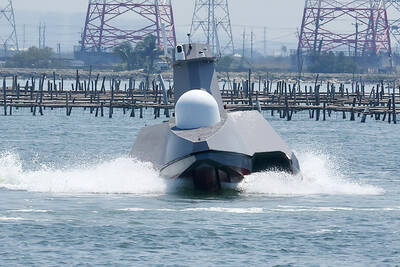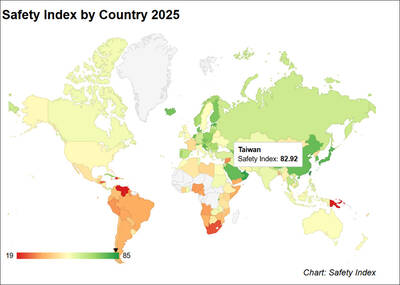The Pentagon is planning to move a number of armed drone aircraft to its Pacific Command force from where they could be used in part to support Taiwan’s security and guard against a surprise attack by China.
Equipped with state-of-the-art surveillance cameras, the Predator and Reaper unmanned aerial vehicles (UAV) would monitor China’s military buildup and North Korea’s nuclear and missile programs.
Quoting a Pentagon official, the Washington Times reported earlier this week that a special task force at the US Joint Chiefs of Staff was studying the move.
The UAV would become available in the coming months as the US draws down forces from theaters in Afghanistan, Pakistan and Iraq.
While it is still not clear just how many drones would be involved, Pentagon plans call for a total worldwide force of 33 Predators and 32 Reapers — and support staff of about 12,000 — to be flying over the next few years.
They have a budget of about US$5 billion this year.
The Predator costs about US$5 million per unit, while the Reaper is about US$10.5 million per aircraft.
Military sources said the Predators and Reapers, which can stay up for 24 hours at a speed of 644kph, would most likely be stationed in South Korea and Okinawa, Japan.
Last year, the US military stationed Global Hawk surveillance drones in Guam.
Together with the Global Hawks, the Predator and Reaper drones would monitor the movements of China’s expanding forces, its coastal missile batteries — including those in provinces directly across from Taiwan — and watch remote islands that are claimed by competing Asian countries including Taiwan and China.
John Pike, head of the -Washington-based Global Security think tank, told the Taipei Times that the Predators and Reapers would probably be used to monitor the Chinese coast where they could provide more “persistent” coverage than is provided by spy satellites.
They would be particularly useful, he said, in following Chinese military exercises, including missile drills.
“It all helps Taiwan’s security,” Pike said.
Data gathered by the drones can be transmitted almost instantly to bases on the ground, while they could also fire deadly accurate missiles in emergency situations.
US Air Force Colonel James Sculerati told a conference on military drones this week that future drone missions would include more night flights and flights in difficult weather.
“We already do a lot of work at night. We are going to do more work in weather [and] we are -going to do more work in difficult terrain. We need vehicles that are capable of flying in darkness, in all weather,” he said.
Many analysts believe drones will eventually replace manned fighter aircraft.
While China’s drones are believed to be several years behind US models in development, there are concerns that Beijing could be catching up.
The US-China Economic and Security Review Commission recently reported: “The PLA [People’s Liberation Army] Air Force had deployed several types of unmanned aerial vehicles for both reconnaissance and combat purposes.
“In addition, China is developing a variety of medium and high-altitude long-endurance unmanned vehicles, which when deployed, will expand the PLA Air Force’s options for long-range reconnaissance and strike,” it said.

ENDEAVOR MANTA: The ship is programmed to automatically return to its designated home port and would self-destruct if seized by another party The Endeavor Manta, Taiwan’s first military-specification uncrewed surface vehicle (USV) tailor-made to operate in the Taiwan Strait in a bid to bolster the nation’s asymmetric combat capabilities made its first appearance at Kaohsiung’s Singda Harbor yesterday. Taking inspiration from Ukraine’s navy, which is using USVs to force Russia’s Black Sea fleet to take shelter within its own ports, CSBC Taiwan (台灣國際造船) established a research and development unit on USVs last year, CSBC chairman Huang Cheng-hung (黃正弘) said. With the exception of the satellite guidance system and the outboard motors — which were purchased from foreign companies that were not affiliated with Chinese-funded

PERMIT REVOKED: The influencer at a news conference said the National Immigration Agency was infringing on human rights and persecuting Chinese spouses Chinese influencer “Yaya in Taiwan” (亞亞在台灣) yesterday evening voluntarily left Taiwan, despite saying yesterday morning that she had “no intention” of leaving after her residence permit was revoked over her comments on Taiwan being “unified” with China by military force. The Ministry of the Interior yesterday had said that it could forcibly deport the influencer at midnight, but was considering taking a more flexible approach and beginning procedures this morning. The influencer, whose given name is Liu Zhenya (劉振亞), departed on a 8:45pm flight from Taipei International Airport (Songshan airport) to Fuzhou, China. Liu held a news conference at the airport at 7pm,

Taiwan was ranked the fourth-safest country in the world with a score of 82.9, trailing only Andorra, the United Arab Emirates and Qatar in Numbeo’s Safety Index by Country report. Taiwan’s score improved by 0.1 points compared with last year’s mid-year report, which had Taiwan fourth with a score of 82.8. However, both scores were lower than in last year’s first review, when Taiwan scored 83.3, and are a long way from when Taiwan was named the second-safest country in the world in 2021, scoring 84.8. Taiwan ranked higher than Singapore in ninth with a score of 77.4 and Japan in 10th with

GRIDLOCK: The National Fire Agency’s Special Search and Rescue team is on standby to travel to the countries to help out with the rescue effort A powerful earthquake rocked Myanmar and neighboring Thailand yesterday, killing at least three people in Bangkok and burying dozens when a high-rise building under construction collapsed. Footage shared on social media from Myanmar’s second-largest city showed widespread destruction, raising fears that many were trapped under the rubble or killed. The magnitude 7.7 earthquake, with an epicenter near Mandalay in Myanmar, struck at midday and was followed by a strong magnitude 6.4 aftershock. The extent of death, injury and destruction — especially in Myanmar, which is embroiled in a civil war and where information is tightly controlled at the best of times —